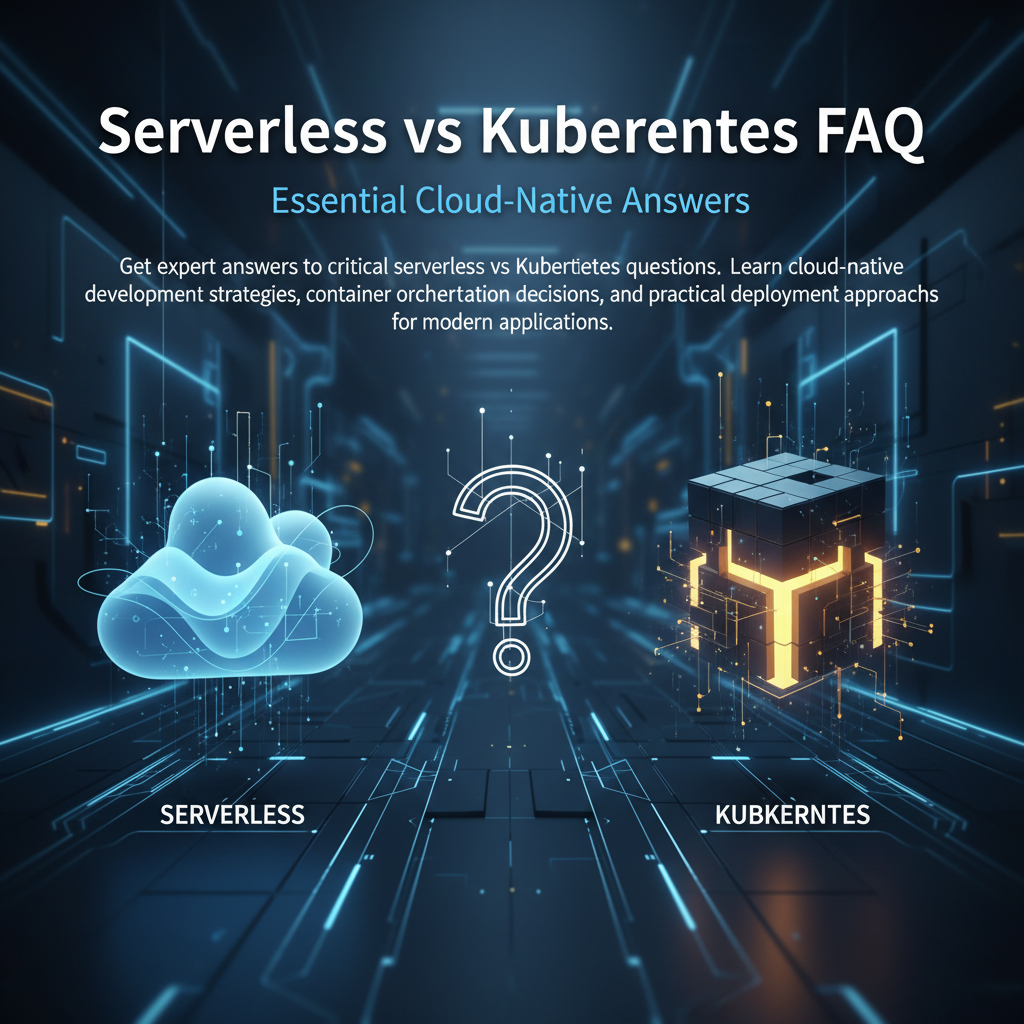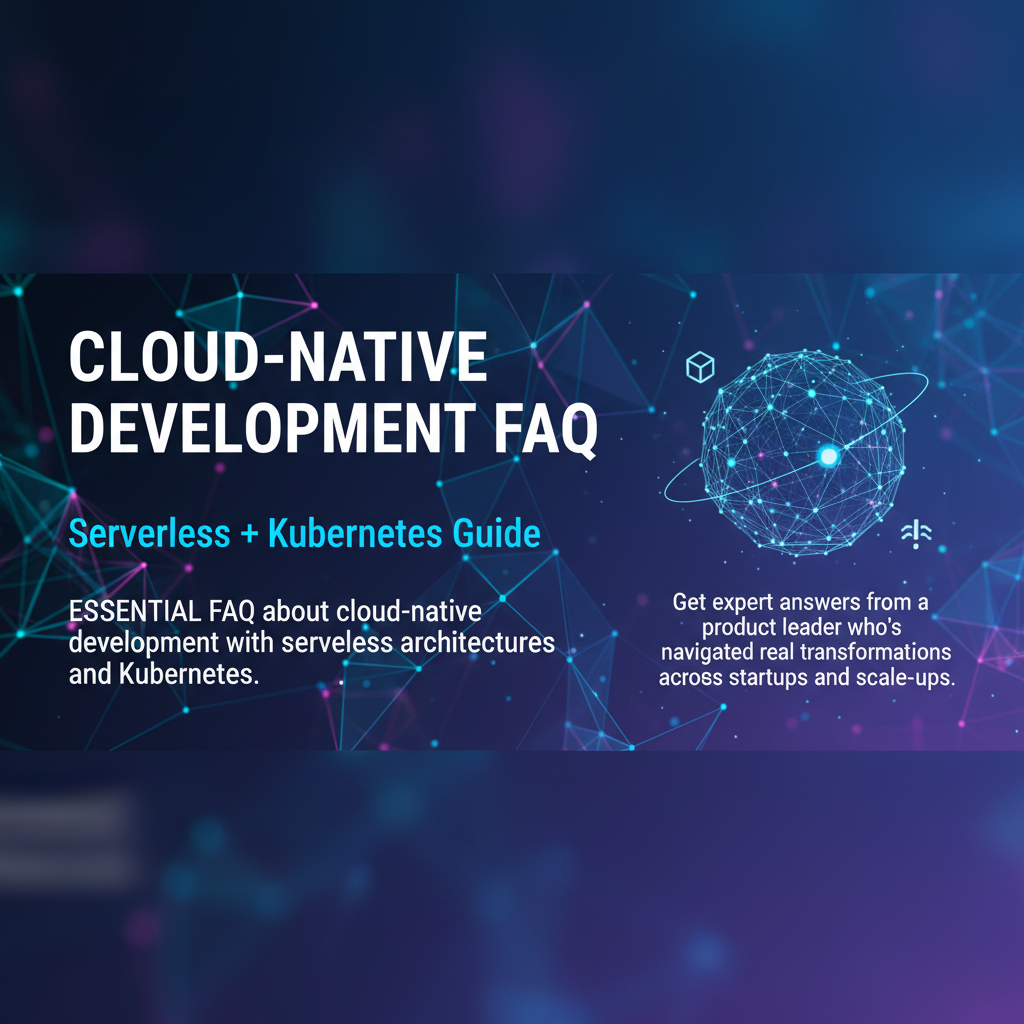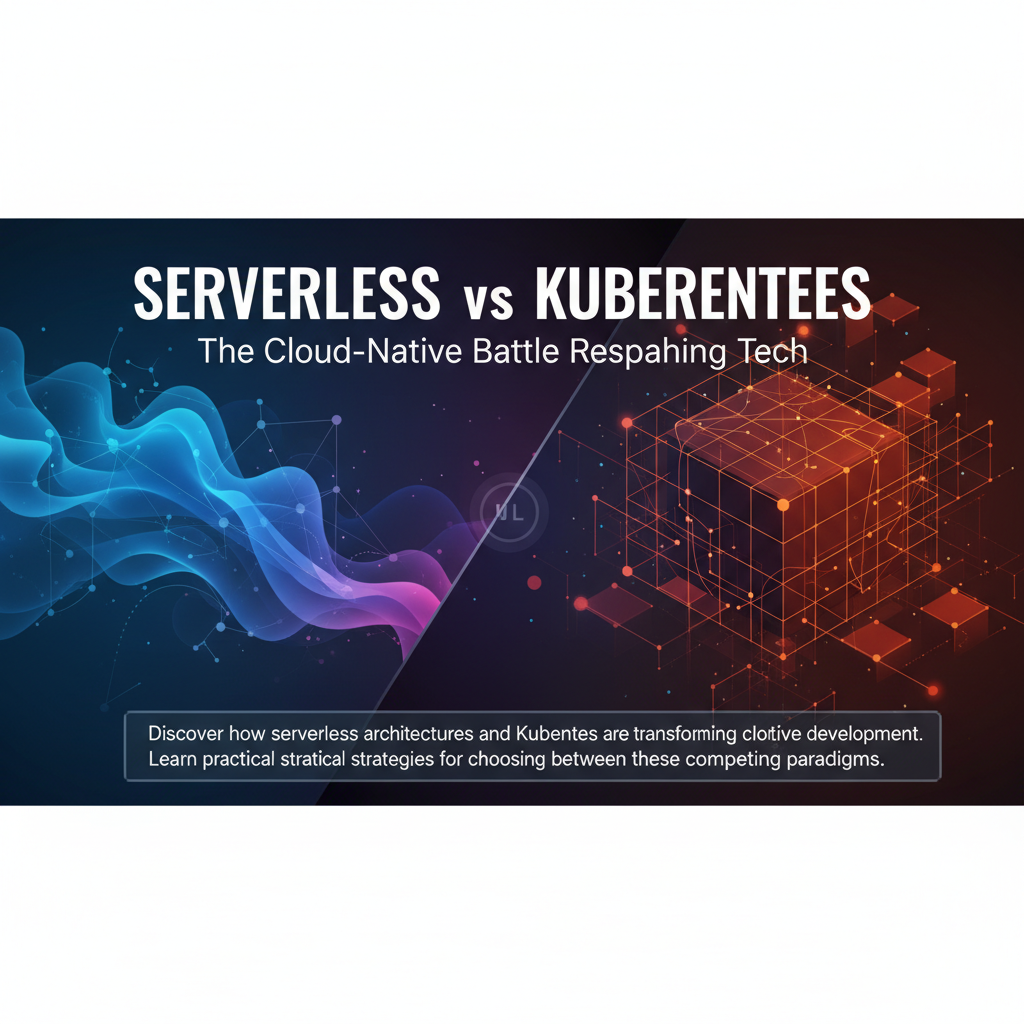Cloud-Native Development: Why Serverless + Kubernetes = Future
How serverless architectures and Kubernetes are reshaping modern development. Learn from a product leader's journey through cloud-native transformation failures and wins.
The Cloud-Native Development Revolution Nobody Talks About
"Amina, our infrastructure costs just tripled, and half our features are broken." That Slack message from our CTO at 2 AM still haunts me. We'd just completed our "cloud-native transformation" – migrating everything to serverless functions and Kubernetes clusters because, well, that's what modern companies do, right?
Three months earlier, I was sitting in a board meeting confidently presenting our cloud-native development strategy. Serverless architectures would make us infinitely scalable. Kubernetes would solve all our deployment headaches. We'd be the poster child for modern development practices.
The reality? Our AWS bill exploded from £3,000 to £12,000 monthly. Our deployment pipeline went from 10 minutes to 45 minutes. And our engineers – brilliant people who could build anything – were spending more time debugging YAML files than writing features.
This isn't another "cloud-native is hard" story. It's about understanding why serverless architectures and Kubernetes aren't just technical decisions – they're product strategy decisions that can make or break your roadmap.
I've now guided five companies through cloud-native transformations, including our current healthtech startup ShifaAI, where we serve 2.8M users across emerging markets with a hybrid serverless-Kubernetes architecture that actually works. The difference between success and that 2 AM panic message? Understanding that cloud-native development isn't about choosing between serverless and Kubernetes – it's about matching your infrastructure decisions to your product strategy.
Here's what I've learned about making cloud-native development actually drive business value, not just engineering complexity.
Why Serverless Architecture Is Winning the Scalability Game
Let me share what changed everything for us at ShifaAI. We were processing patient triage requests across Bangladesh, Nigeria, and Kenya – traffic that could spike 1000% during health emergencies but drop to near-zero at night.
Traditional infrastructure meant paying for peak capacity 24/7. Serverless functions changed that math completely. Our core triage algorithm runs on AWS Lambda, scaling from zero to thousands of concurrent executions automatically. We pay only for actual usage – down to the 100ms.
The Real Serverless Advantages:
Zero Infrastructure Management: No servers to patch, no capacity planning spreadsheets, no 3 AM alerts about crashed instances. According to Datadog's State of Serverless report, companies using serverless report 65% less time spent on infrastructure maintenance.
True Pay-Per-Use Economics: Our patient intake function costs us £0.03 per thousand requests. During off-peak hours in rural areas, we might process 50 requests daily. During health crises, we've handled 50,000 requests in an hour. Same code, same performance, but costs scale linearly with value delivered.
Instant Global Distribution: Serverless functions deploy to multiple regions simultaneously. When we launched in Kenya, our response times were sub-200ms on day one – not because we provisioned Kenyan servers, but because AWS Lambda already had our code running in Africa.
But here's what the tutorials don't tell you: Serverless architecture isn't magic. It's a tradeoff that makes sense when your workload is event-driven, stateless, and has unpredictable traffic patterns.
Our billing system? Still runs on traditional servers because it needs persistent connections and complex state management. Our AI model inference? Serverless, because each patient diagnosis is an independent, stateless operation.
The key insight: Serverless shines for specific use cases, not entire applications. Companies trying to force everything into Lambda functions end up with the complexity of microservices without the benefits of proper orchestration.
Kubernetes Dominance: Why Container Orchestration Rules Complex Systems
"Kubernetes is overkill for startups" – I used to say this. Then we tried to coordinate 23 microservices across 4 data centers without proper orchestration. The result was a infrastructure disaster that taught me why Kubernetes has become the default choice for serious applications.
Kubernetes isn't just container management – it's a distributed systems operating system. At ShifaAI, it orchestrates our patient data pipeline: ingestion services, ML inference engines, notification systems, and compliance auditing tools all working together seamlessly.
Why Kubernetes Dominates:
Declarative Infrastructure as Code: Instead of scripting "do this, then this," you declare "I want 3 replicas of this service with these resource limits." Kubernetes figures out how to make it happen and maintains that state automatically.
Self-Healing by Default: When our ML inference pod crashes (which happens when processing edge cases in medical data), Kubernetes restarts it within seconds. No manual intervention, no alerts waking up engineers. According to CNCF surveys, 93% of organizations report improved system reliability after Kubernetes adoption.
Resource Efficiency Through Intelligent Scheduling: Kubernetes places workloads based on actual resource usage, not guesswork. Our patient triage services share nodes with batch processing jobs – high-priority real-time work gets resources immediately, while background tasks use leftover capacity.
Multi-Cloud Portability: Same YAML configs work on AWS, Google Cloud, or Azure. When we needed GDPR compliance for European patients, we deployed identical services to EU regions without infrastructure rewrites.
But Kubernetes complexity is real. Our first deployment took 6 weeks and required hiring a dedicated DevOps engineer. The learning curve is steep because you're not just learning a tool – you're learning distributed systems concepts.
The Strategic Decision Framework:
- Choose Kubernetes when you have multiple interconnected services, complex deployment requirements, or need fine-grained resource control
- Avoid Kubernetes when you have simple, stateless applications or a team without container orchestration experience
The magic happens when Kubernetes manages the complexity you already have, not when it adds complexity to simple applications.
My £50K Cloud-Native Transformation Disaster (And What It Taught Me)
The Slack notification arrived at 11:47 PM: "Critical: Payment processing down. Revenue impact: £2,400/hour."
I was three weeks into my role as Director of Product at a fintech startup that had just completed their "cloud-native transformation." Everything was containerized, deployed on Kubernetes, with serverless functions handling payment webhooks. On paper, it looked like architectural perfection.
In reality, it was a £50,000 lesson in why cloud-native development requires more than just modern tooling.
Here's what went wrong: Our previous monolithic Rails app processed payments reliably for two years. But "monoliths are legacy," so we'd split it into 12 microservices. Each service ran in its own Kubernetes pod, communicating through message queues and REST APIs.
The payment failure cascaded like this:
- A serverless webhook function received a payment notification
- It queued a message for the payment processing service
- That service was scaling down due to low traffic
- By the time it scaled up, the message queue had timed out
- No retry logic, no dead letter queue, no fallback
- Payments just... disappeared
Sitting in that war room at midnight, our CTO said something that still guides my infrastructure decisions: "We optimized for problems we didn't have and created problems we couldn't solve."
The real issue wasn't technical – it was strategic. We'd adopted cloud-native patterns without understanding our actual constraints:
- We weren't Netflix with thousands of engineers
- Our traffic was predictable, not highly variable
- Our team expertise was in Rails, not distributed systems
- Our biggest risk was regulatory compliance, not scalability
Recovering took six weeks and £23,000 in consultant fees. But it taught me that successful cloud-native development starts with honest assessment: What problems are you actually solving? What complexity can your team realistically handle?
Now, when teams ask about cloud-native transformation, I ask them to describe their current pain points first. Often, the answer isn't serverless or Kubernetes – it's better monitoring, cleaner code, or more systematic product development.
Serverless vs Kubernetes: Visual Architecture Comparison Guide
Some concepts click better when you see them in action rather than just reading about them. The relationship between serverless architectures and Kubernetes orchestration is one of those topics that becomes much clearer with visual examples.
This video walks through real-world scenarios where each approach shines, showing actual AWS Lambda functions scaling in response to traffic spikes, and Kubernetes pods being orchestrated across a multi-node cluster. You'll see side-by-side comparisons of deployment pipelines, cost implications, and performance characteristics.
What makes this particularly valuable is the visualization of how these technologies complement rather than compete with each other. Many successful cloud-native applications use both – serverless for event-driven processing and Kubernetes for long-running services.
Pay attention to the section on hybrid architectures around the 8-minute mark – it shows exactly how companies like Netflix and Spotify structure their cloud-native systems using both approaches strategically. The resource utilization graphs are especially enlightening for understanding when each approach delivers better cost efficiency.
This visual perspective will help you make more informed architectural decisions and avoid the "all serverless" or "all Kubernetes" trap that catches many development teams.
Strategic Cloud-Native Development: Beyond the Hype Cycle
After implementing cloud-native architectures at five companies, I've learned that success isn't about choosing the right technology – it's about matching infrastructure decisions to business strategy.
Here's the framework I use for strategic cloud-native development:
Start with Business Constraints, Not Technical Preferences
At ShifaAI, our primary constraint is regulatory compliance across multiple countries. GDPR in Europe, local health data laws in Bangladesh, varying requirements in African markets. This drove our architecture more than scalability concerns.
Our solution: Kubernetes for compliance-heavy services that need audit trails and data residency controls, serverless for stateless operations that can run anywhere. The decision tree wasn't "what's more modern" but "what passes regulatory audits."
The Hybrid Approach That Actually Works
Most successful cloud-native applications I've seen use both serverless and Kubernetes strategically:
- Serverless for: Event processing, API gateways, batch jobs, webhooks
- Kubernetes for: Databases, ML model serving, real-time communications, stateful services
- Traditional infrastructure for: Legacy integrations, compliance-critical systems, cost-sensitive workloads
Implementation Strategy That Minimizes Risk
-
Identify your strangler fig candidates: Which components can be extracted and modernized without affecting core business logic?
-
Build cloud-native capabilities gradually: Don't rewrite everything. Add new features using cloud-native patterns while keeping existing systems stable.
-
Invest in observability first: You can't manage what you can't measure. Modern distributed systems require sophisticated monitoring and debugging tools.
-
Plan for operational complexity: Cloud-native systems trade development complexity for operational complexity. Ensure your team has the skills and tools to manage distributed systems.
The Real Success Metrics
Forget vanity metrics like "number of microservices" or "serverless adoption percentage." Focus on business outcomes:
- Time from idea to production
- System reliability and uptime
- Developer productivity and satisfaction
- Infrastructure costs as percentage of revenue
- Ability to scale with business growth
Cloud-native development should make your product development faster, more reliable, and more responsive to user needs. If it's not delivering those outcomes, you're optimizing for the wrong things.
From Cloud-Native Infrastructure to Systematic Product Intelligence
The cloud-native development revolution has taught us something profound: modern applications require systematic approaches, not ad-hoc solutions. Serverless architectures work because they systematically handle scaling. Kubernetes dominates because it systematically manages complexity. The pattern is clear – success comes from replacing guesswork with systematic thinking.
Key Takeaways for Your Cloud-Native Journey:
- Architecture decisions are product strategy decisions – choose based on business constraints, not technical preferences
- Hybrid approaches beat purity – use serverless and Kubernetes where each excels
- Operational complexity is real – invest in observability and team skills before scaling
- Start small and evolve systematically – strangler fig patterns minimize risk while enabling modernization
- Measure business outcomes, not technical metrics – focus on delivery speed and reliability
But here's what I've realized after years of infrastructure transformations: the same vibe-based development that clouds architectural decisions also sabotages product development itself.
We spend months perfecting our serverless functions and Kubernetes deployments, then build features based on hunches, scattered feedback, and executive opinions. We have systematic infrastructure serving unsystematic product decisions.
The "Vibe-Based Development" Crisis Nobody Talks About
Just like that £50K infrastructure disaster I shared earlier, most product failures aren't technical – they're strategic. Research shows 73% of features don't drive user adoption because teams build based on assumptions rather than systematic analysis. Product managers spend 40% of their time on wrong priorities because feedback comes from everywhere: sales calls, support tickets, Slack messages, executive requests.
Sound familiar? It's the same chaos that led us to adopt cloud-native architectures, just one layer up the stack.
glue.tools: The Central Nervous System for Product Decisions
This is exactly why we built glue.tools – to bring the same systematic thinking that revolutionized infrastructure to product development itself.
Think of glue.tools as the Kubernetes for product management. Just as Kubernetes transforms scattered containers into orchestrated systems, glue.tools transforms scattered feedback into prioritized, actionable product intelligence.
Our AI-powered platform aggregates feedback from customer conversations, support tickets, sales calls, and user analytics. It automatically categorizes, deduplicates, and connects related insights across touchpoints. No more hunting through Slack threads or trying to remember what that important customer said three weeks ago.
The 77-Point Scoring Algorithm That Thinks Like a Senior Product Strategist
But aggregation is just the beginning. Our proprietary scoring algorithm evaluates every insight across 77 factors: business impact, technical effort, strategic alignment, user segment importance, competitive implications, and implementation dependencies.
The result? A prioritized backlog that reflects actual user needs and business value, not the loudest voice in the room. Your engineering team gets clear, justified priorities. Sales knows what's actually being built and when. Support can set realistic customer expectations.
Everything stays in sync automatically. When priorities change, every department gets updated context and business rationale.
The Complete 11-Stage AI Analysis Pipeline
Just as your cloud-native infrastructure follows systematic deployment pipelines, glue.tools processes every product decision through an 11-stage AI analysis pipeline that thinks like your most experienced product strategist:
Strategy analysis → persona mapping → JTBD identification → use case generation → story creation → technical schema design → screen flows → interactive prototypes → implementation planning → dependency mapping → success metrics definition.
What emerges isn't just another feature request – it's a complete specification package: PRDs with clear success metrics, user stories with acceptance criteria, technical blueprints that actually compile, and interactive prototypes that demonstrate the user experience.
Your developers aren't guessing about requirements. Your designers aren't assuming user needs. Your stakeholders aren't wondering about business value. Everything is systematically derived from real user feedback and strategic business context.
Forward Mode and Reverse Mode: Complete Product Intelligence
Forward Mode starts with strategy and generates everything downstream: "Strategy → personas → JTBD → use cases → stories → schema → screens → prototype." Perfect for new features and product initiatives.
Reverse Mode analyzes existing code and tickets to reconstruct the product intelligence: "Code & tickets → API & schema map → story reconstruction → tech-debt register → impact analysis." Essential for understanding and improving existing products.
Both modes create continuous feedback loops that automatically parse changes – whether from user feedback, market shifts, or technical constraints – into concrete edits across specs, stories, and HTML prototypes.
The Business Impact: From Reactive to Strategic
Companies using glue.tools report 300% average ROI improvement because systematic product intelligence prevents the costly rework that comes from building based on vibes instead of specifications. Features ship faster because requirements are clear. User adoption increases because products solve real problems. Engineering teams stay motivated because they're building valuable functionality.
It's like having Cursor for product managers – making the entire product development process 10× faster and more systematic, just like AI code assistants transformed development productivity.
Your Cloud-Native Infrastructure Deserves Systematic Product Intelligence
You've invested in serverless architectures and Kubernetes orchestration because systematic approaches outperform ad-hoc solutions. Your product development process deserves the same systematic transformation.
Hundreds of product teams worldwide trust glue.tools to transform scattered feedback into systematic product intelligence. Ready to experience the difference between vibe-based development and systematic product strategy?
Experience glue.tools today – generate your first systematically-derived PRD and see how the 11-stage AI analysis pipeline turns user feedback into specifications that actually compile into profitable products. Your cloud-native infrastructure is ready for systematic product intelligence.
Frequently Asked Questions
Q: What is cloud-native development: why serverless + kubernetes = future? A: How serverless architectures and Kubernetes are reshaping modern development. Learn from a product leader's journey through cloud-native transformation failures and wins.
Q: Who should read this guide? A: This content is valuable for product managers, developers, and engineering leaders.
Q: What are the main benefits? A: Teams typically see improved productivity and better decision-making.
Q: How long does implementation take? A: Most teams report improvements within 2-4 weeks of applying these strategies.
Q: Are there prerequisites? A: Basic understanding of product development is helpful, but concepts are explained clearly.
Q: Does this scale to different team sizes? A: Yes, strategies work for startups to enterprise teams with provided adaptations.



